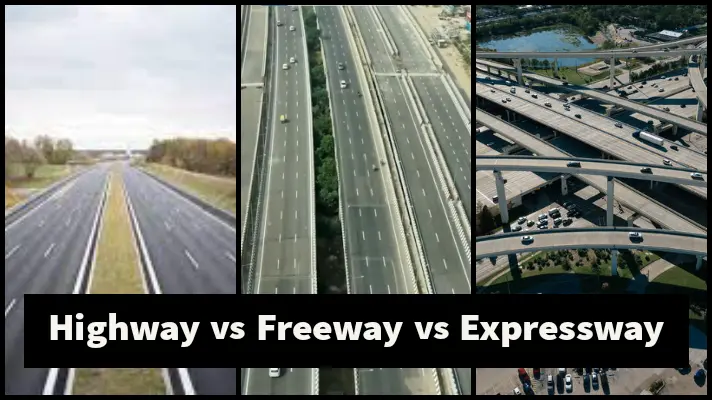Highway vs Freeway vs Interstate vs Expressway we learn in this advantage and Disadvantage of this Construction roads in this post we learn detail information about roads in USA.
Table of Contents
Highways in USA Highway vs Freeway
Highway vs Freeway vs Interstate vs Expressway
A highway is a main road intended for travel between cities and towns. It may have intersections, traffic signals, and pedestrian crossings.
A freeway is a controlled-access highway with no traffic signals or intersections, allowing for uninterrupted travel at high speeds.
An interstate is part of the Interstate Highway System, designed for long-distance travel with high standards for construction, including multiple lanes and limited access points.
An expressway is a divided highway with partial access control, allowing for higher speeds but with some at-grade intersections and traffic signals.
Advantages of Highway
Connectivity: Highways provide essential connectivity between towns, cities, and regions.
Accessibility: They facilitate easy access to various destinations, promoting economic activities.
Versatility: Highways can accommodate various types of vehicles, including cars, trucks, and buses.
Disadvantages of Highway
Traffic Congestion: Highways in urban areas may experience traffic congestion during peak hours.
Safety Concerns: High traffic volumes may lead to safety concerns, especially in areas with intersections and driveways.
Environmental Impact: Construction and maintenance of highways may have environmental impacts on surrounding areas.
Freeways in USA
Advantages of Freeways
Efficient Traffic Flow: Freeways are designed for smooth and uninterrupted traffic flow, reducing travel time.
Safety: Limited access points and controlled design contribute to improved safety.
High Capacity: Freeways can handle high volumes of traffic, making them suitable for long-distance travel.
Disadvantages of Freeways
Construction Costs: Building and maintaining freeways can be expensive due to stringent design standards.
Limited Accessibility: Limited access points may require detours for local access, impacting nearby businesses.
Environmental Impact: Freeway construction can have environmental consequences, such as habitat disruption.
Interstates in USA
Advantages of Interstates
National Connectivity: Interstates connect major cities and regions on a national scale, supporting economic development.
Consistency: Strict federal standards ensure a consistent and high-quality road network.
Efficient Travel: Interstates are designed for high-speed, long-distance travel, enhancing efficiency.
Disadvantages of Interstates
Construction Costs: Interstate construction and maintenance can be costly due to federal standards.
Environmental Impact: Large-scale projects may have significant environmental impacts.
Limited Local Access: Limited access points may require detours for local access, impacting nearby communities.
Expressways in USA
Advantages of Expressways
Efficient Urban Travel: Expressways in urban areas facilitate efficient travel with controlled access points.
Reduced Congestion: Limited access helps reduce traffic congestion and improves overall traffic flow.
Safety: Controlled design contributes to improved safety for motorists.
Disadvantages:Construction Costs: Building and maintaining expressways can be expensive.Limited Accessibility: Limited access points may require detours for local access.Land Use Impact: Construction may impact local land use and communities.
Disadvantages of Expressways
- Construction Costs: Building and maintaining expressways can be expensive.
- Limited Accessibility: Limited access points may require detours for local access.
- Land Use Impact: Construction may impact local land use and communities.
Highway vs. Freeway vs. Interstate vs. Expressway: Key Differences
| Aspect | Highway | Freeway | Interstate | Expressway |
|---|---|---|---|---|
| Definition | Any public road connecting destinations | A specific type of highway with controlled access | Network of freeways within the United States; prefixed with “I” | High-speed road with controlled access |
| Access Control | Various access points, including intersections and driveways | Controlled access with on/off-ramps and interchanges; no at-grade intersections | Controlled access similar to other freeways | Controlled access with on/off-ramps and limited intersections |
| Design Standards | Varies based on local needs | Higher design standards for smooth traffic flow; multiple lanes in each direction | Subject to strict federal design standards; maintains consistency and high-quality standards | Designed for higher speeds and efficiency |
| Traffic Flow | Traffic interruptions possible (e.g., stoplights, intersections) | Designed for uninterrupted flow at higher speeds; emphasizes efficiency and safety | Designed for high-speed, long-distance travel | Facilitates smoother and faster traffic flow |
| Examples | Local roads, state routes, interconnecting roads | Interstates (e.g., I-95, I-405), other controlled-access expressways | Interstate 10 (I-10), Interstate 95 (I-95) | Various expressways in urban and suburban areas |
| Purpose | Serves general traffic needs and local transportation | Primarily designed for efficient long-distance travel and regional connectivity | Connects major cities and regions across the country; facilitates national and interstate travel | Balances speed and access in urban and suburban settings |
Highway vs. Freeway vs. Interstate: Key Differences
| Aspect | Highway | Freeway | Interstate |
|---|---|---|---|
| Definition | Any public road connecting destinations | A specific type of highway with controlled access | Network of freeways within the United States; prefixed with “I” |
| Access Control | Various access points, including intersections and driveways | Controlled access with on/off-ramps and interchanges; no at-grade intersections | Controlled access similar to other freeways |
| Design Standards | Varies based on local needs | Higher design standards for smooth traffic flow; multiple lanes in each direction | Subject to strict federal design standards; maintains consistency and high-quality standards |
| Traffic Flow | Traffic interruptions possible (e.g., stoplights, intersections) | Designed for uninterrupted flow at higher speeds; emphasizes efficiency and safety | Designed for high-speed, long-distance travel |
| Examples | Local roads, state routes, interconnecting roads | Interstates (e.g., I-95, I-405), other controlled-access expressways | Interstate 10 (I-10), Interstate 95 (I-95) |
| Purpose | Serves general traffic needs and local transportation | Primarily designed for efficient long-distance travel and regional connectivity | Connects major cities and regions across the country; facilitates national and interstate travel |
Highway vs. Freeway: Key Differences
| Aspect | Highway | Freeway |
|---|---|---|
| Definition | Any public road connecting destinations | A specific type of highway with controlled access |
| Access Control | Various access points, including intersections and driveways | Controlled access with on/off-ramps and interchanges; no at-grade intersections |
| Design Standards | Varies based on local needs | Higher design standards for smooth traffic flow; multiple lanes in each direction |
| Traffic Flow | Traffic interruptions possible (e.g., stoplights, intersections) | Designed for uninterrupted flow at higher speeds; emphasizes efficiency and safety |
| Geographical Context | Found in urban, suburban, and rural areas | Often located in densely populated areas where controlled access is crucial |
| Common Characteristics | Includes local roads, arterials, expressways | A subset characterized by limited access and high-speed design |
| Examples | Local roads, state routes, interconnecting roads | Interstates (e.g., I-95, I-405), other controlled-access expressways |
| Purpose | Serves general traffic needs and local transportation | Primarily designed for efficient long-distance travel and regional connectivity |
| Traffic Control Devices | Traffic signals, stop signs, various intersections | Relies on on/off-ramps, interchanges, and signage for traffic control |
| Safety Considerations | Varied safety features based on local requirements | Strict safety standards, including crash barriers and controlled access points |
Conclusion
In conclusion, collusion represents a clandestine and often illegal collaboration between individuals or entities with the aim of manipulating markets, fixing prices, or restricting competition. This practice is in direct violation of antitrust laws and ethical business standards. Authorities, such as antitrust agencies, vigorously investigate and prosecute collusion cases to preserve fair competition and protect the interests of consumers and competitors. Collusion not only undermines the principles of fair business practices but also has the potential to inflict harm on the broader economy. The legal consequences for engaging in collusion are severe, reinforcing the importance of promoting transparency, competition, and integrity in business interactions.
FAQ
What is the difference between a highway and a freeway?
A highway is a general term for any public road connecting destinations, while a freeway is a specific type of highway with controlled access, featuring on/off-ramps and interchanges.
Are all freeways interstates?
No, not all freeways are interstates. Interstates are a subset of freeways that form a national network in the United States, identified by the “I” prefix (e.g., I-95).
What are the advantages of highways?
Highways provide essential connectivity, accessibility to various destinations, and accommodate various types of vehicles.
What are the disadvantages of freeways?
Freeways can be expensive to build and maintain, have limited local accessibility, and may impact the environment during construction.
How do interstates differ from other freeways?
Interstates are a specific type of freeway that connects major cities and regions on a national scale, adhering to strict federal design standards.
What is the primary purpose of expressways ?
Expressways in urban areas are designed for efficient travel with controlled access points, reducing congestion and improving traffic flow.
What is the main disadvantage of limited access points on freeways?
Limited access points on freeways may require detours for local access, impacting nearby businesses and communities.
Why are interstates considered consistent?
Interstates adhere to strict federal standards, ensuring consistency and high quality throughout the national network.
How to Start Construction site
Comprehensive Guide to Construction Estimating Software

Hi! I’m Sandip, a civil engineer who loves sharing about Civil Engineering & new ideas and tips. My blog helps you learn about engineering in a fun and easy way!


Have you ever thought about creating an e-book or guest authoring on other websites?
I have a blog centered on the same ideas you discuss and would
really like to have you shhare some stories/information. I know my viewers would
value your work. If you’re even remotely interested, feel free to send mme an e
mail. https://Evolution.Org.ua/